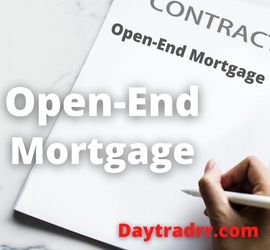What Is an Open-End Mortgage?
 An Open-End Mortgage is an expandable loan that allows a borrower to access home equity appreciation for additional funds at a later date. It blends some features of a traditional mortgage with some advantages of a home equity line of credit or HELOC.
An Open-End Mortgage is an expandable loan that allows a borrower to access home equity appreciation for additional funds at a later date. It blends some features of a traditional mortgage with some advantages of a home equity line of credit or HELOC.
An open-end mortgage allows the borrower to increase the amount of the mortgage principal outstanding at a later time. As owner equity increases, open-end mortgages permit the borrower to go back to the lender and borrow more money. There is usually a set dollar limit on the additional amount that can be borrowed.
An open-end mortgage saves the borrower the time and trouble of looking for a loan elsewhere. It’s a sort of revolving credit in which the borrower can tap into the same loan up to a certain limit. Banks typically establish a maximum loan-to-value ratio. As a result, the total loan, both the initial and the top-up, will not be allowed to exceed the pre-established loan-to-value ratio.
How an Open-End Mortgage Works
An open-end mortgage has similarities to a delayed draw term loan. It also contains revolving credit-like similarities. Open-end mortgages are distinct in that they are loan agreements secured by a real estate property. Any cash distribution is solely intended toward investment in that property. The application process is nearly identical to that of other credit products. Also, the loan terms are determined by a borrower’s credit score and credit profile. Co-borrowers may have a better chance of getting an open-end mortgage if they have reduced default risk.
Open-end mortgages can provide a borrower with a maximum principal amount that they can access over a predetermined time period. The borrower can use a portion of the loan value approved to finance the costs of their home. Because the borrower is only required to make interest payments on the outstanding balance, taking only a fraction allows them to pay reduced interest.
In an open-end mortgage, the borrower can receive the loan principal at any time specified in the terms of the loan. The amount available to borrow may also be tied to the value of the home. An open-end mortgage is different from a delayed draw term loan because the borrower usually does not have to meet any specific milestones in order to obtain additional funds. An open-end mortgage differs from revolving credit because the funds are usually available only for a specified time. The terms of revolving credit specify that the funds stay open indefinitely, with the exception being if a borrower defaults. In an open-end mortgage, the drawdowns from the available credit can also only be used against the secured collateral. Therefore, payouts must go toward the real estate property for which the lender has the title. (Source: investopedia.com)
Open-End Mortgage: Getting Approved
An open-end mortgage and a traditional mortgage have a similar application process. Homeowners who want to apply for an open-end loan should know that they’ll have to document a number of things. These would include proof of their income, assets, employment, and credit score. Lenders will also want to know how much of a current mortgage is still outstanding. Also, going in you need to understand that not all lenders have the same standards. For example, you probably knew ahead of time exactly what you needed to qualify for an FHA or conventional loan. However, applying for an open-end loan will certainly expose you to another round of financial scrutiny.
Here are general requirements to consider:
- Healthy credit – A credit score of at least 660. Many lenders require a minimum score of 680 or 700
- Owner equity – A loan-to-value ratio of 80% or less
- Low debt ratio – A debt-to-income ratio of 40-45% or less
Your lender will demand confirmation of a good credit score and a low debt ratio, regardless of their specific eligibility conditions. Borrowers who can meet these specifications have the best chance of getting an open-end loan. (Source: americanfinancing.net)
Advantages of an Open-End Mortgage
An open-end mortgage is particularly beneficial to a borrower who qualifies for a larger loan principal amount than is required to purchase a home. An open-end mortgage allows a borrower to take out more credit on their first mortgage. This generally provides a lower interest rate than a subsequent second mortgage. Further, the borrower has the option of using the loan principal to cover any property expenditures that emerge throughout the loan’s term.
Benefits
- Flexibility – The big plus of an open-end mortgage is flexibility. It lets a borrower take cash out of home equity as needed. You only pay interest on the amount you have drawn. For instance, if you take out an open-end mortgage for $400,000 and use $250,000 to purchase the home, you only pay interest on $250,000. If you later tap the mortgage for another $60,000, you would start paying principal and interest on the combined amount. That would be the $60,000 draw plus the initial loan balance of $250,000, minus whatever you have already paid against the principal in the meantime.
- Easy access – It’s easier to take cash from equity using an open-end mortgage. There is no need for getting a home equity loan, HELOC, or cash-out refinancing. With an open-end mortgage, you can request more funds without having to re-qualify or pay closing costs as you would with a second loan.
- Early payment options – Another advantage of an open-end mortgage is that there is generally no penalty for paying off the mortgage before the due date. Traditional mortgages often have a fee or early payment.
- Avoids additional fees – Funds are pre-approved avoiding additional fees in closing costs, appraisal fees, and other expenses required when taking out an additional loan. With the open-end loan, the funds are already there waiting for the borrower, if needed, without going through an entire loan process a second time.
- Rinse and repeat – If you borrow more money using your open-end mortgage and then pay that amount back, you can borrow even more money. You can do this as long as the borrowing period is still open and the total amount you borrow doesn’t exceed the value of the loan-to-value ratio. (Source: smartasset.com)
Disadvantages
- Limited draw period – The draw period of an open-end mortgage is the time during which you can freely borrow money. However, once the draw term expires, the borrower will be unable to withdraw any further cash from equity. A HELOC, on the other hand, has no time restrictions on when the extra money can be borrowed.
- Collateral – Another disadvantage of an open-end mortgage is that your home serves as the sole collateral. If you do not repay the loan on time, you may lose it. That is, you would no longer have a place to reside.
- Depreciation factor – The total amount borrowed, including the original amount and any further draws, will usually not exceed the value of the home. If the value of your home continually appreciates, this will not present a problem. However, if the value of your home declines, this could become an issue for you.
Open-End Mortgage Example
For example, assume a borrower obtains a $400,000 open-end mortgage to purchase a home. The loan has a term of 30 years with a fixed interest rate of 4.75%. The borrower receives rights to the $400,000 principal amount but does not have to take the full amount at once. The borrower may choose to take $250,000, which would require making interest payments at the 4.75% rate on the outstanding balance. Four years later, the borrower may decide to take another $100,000. At that time, the additional $100,000 is added to the outstanding principal. Payments now include 4.75% interest on the total outstanding balance, $250,000 + $100,000 = $350,000). However, payments are less whatever principal amount was paid down during the previous four years.
Up Next: What Does the Phrase Guns and Butter Mean?
 Guns and butter generally refer to the relationship between defense spending and social programs in a federal government’s budget allocations
Guns and butter generally refer to the relationship between defense spending and social programs in a federal government’s budget allocations
The phrase Guns and butter has come to summarize the dynamics involved in a federal government’s allocations to defense versus social programs when allocating limited resources. Both segments can be vital to a country’s economy. Depending on the global security environment, defense spending may take precedence over social, particularly during wartime. War can have a significant impact on a country’s economy as well as its social evolution.




